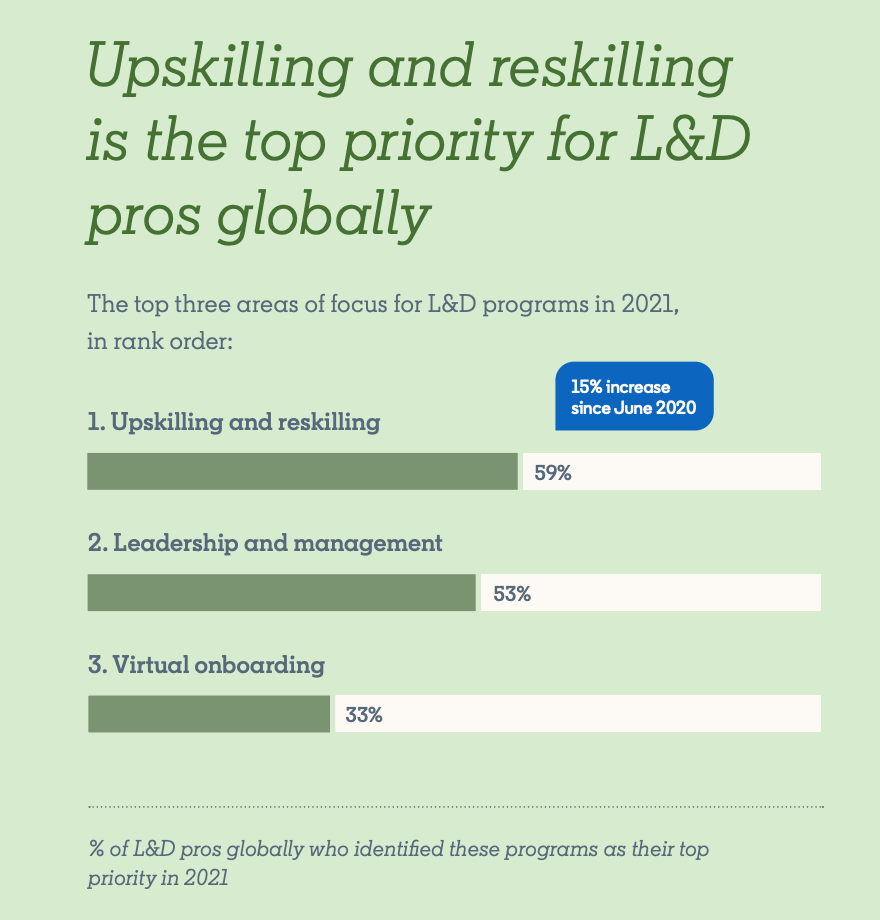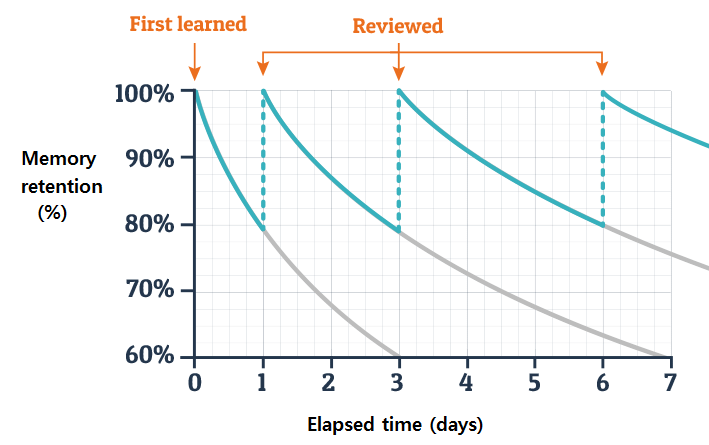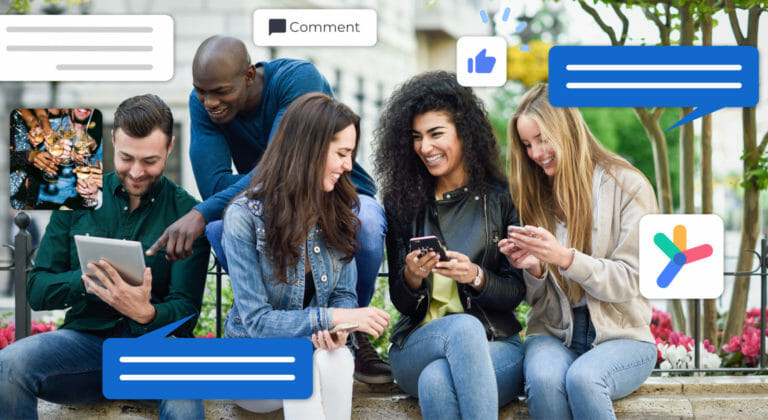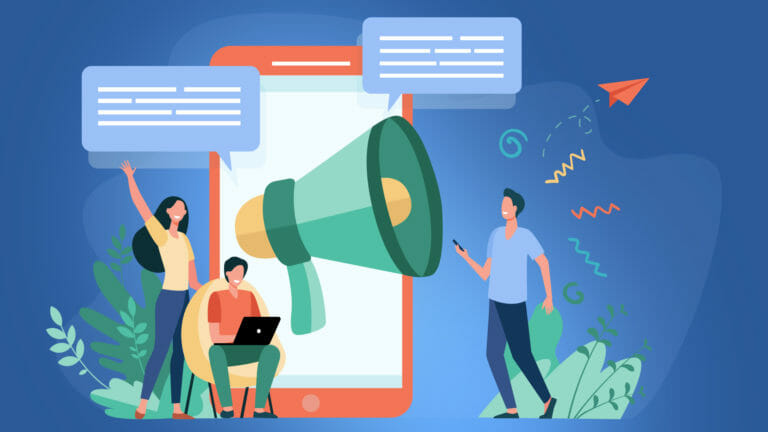With so much uncertainty, employees want the skills to secure a job, whether that be the one they currently have or their next one. Similarly, leaders at all levels are talking about the need to future-proof their workforce. Hiring new employees in the hopes of acquiring a skill set may not be the best option for your business. *Enter initiatives for employee reskilling and upskilling*.
What is the difference between reskilling and upskilling?
| To reskill is to learn new skills to do a different job or train people to do a different job. | To upskill is to learn new skills or to teach workers new skills to be better equipped to do their [current] job. |
Source: Cambridge Dictionary
Many types of employee training are important, including employee onboarding and reskilling, and upskilling. However, the latter 2 may be reigning supreme for a competitive edge in a post-pandemic world. Globally, 79% percent of CEOs are concerned that a lack of essential skills in their workforce is threatening the future growth of their organization. In 2012 in comparison, it was 53%.
Instead of recruiting new hires to fill a skill gap, invest in retraining employees! Upskilling and reskilling employees takes the #1 priority spot for learning and development professionals.

Jump on the bandwagon! Drive impactful training for your employees, but do it well.
Here are 10 best practices to get employee reskilling and upskilling right:
1. Align with goals (and expectations)
For best results, don’t drive employee learning and development aimlessly. Do so with a destination in mind!

Consider what you as a leader need employees to know in order to achieve your organizational goals. This will help you focus on teaching employees skills that truly contribute to the business.
The basics for alignment involve:
- Evaluating your organization’s current situation
- Setting SMART goals (Specific, Measurable, Attainable, Relevant, Time-based)
- Determining what skills are needed (and missing) in your organization to achieve those objectives
- Planning employee reskilling and upskilling initiatives to fill the gaps
Learn more about aligning employee training with business strategy.
Note: Go beyond filling current or short-run organizational needs. Plan reskilling that may help your organization face emerging trends and adapt!
In your L&D planning, remember to relay what you want and need from employees. That’s right. Set expectations for reskilling and upskilling employees. Do you expect a lesson completion, goal achievement in the short run, or overachievement from them in the long run? Let your people know!
2. Make retraining and upskilling accessible
To increase the probability of your workforce completing training, make it accessible. Reminder: people want fast and easy!
This is true, especially for the growing non-desk workforce. Even before the pandemic, deskless employees made up about 80% of the global working population. Given their on-the-go jobs, they actually NEED flexible access to information; reskilling and upskilling included.
Ensure at least part of your plans to teach employees new skills offer them the opportunity to learn when and where they want. Going mobile may be your best bet to do so.
3. Aim for personalized learning
Ensure you are investing time into skill-building that is relevant for your employees. Aim for making it as personalized as possible. Not only do people learn differently, the skills that different workers need also vary depending on their current work situation!

In developing reskilling and upskilling programs for your workforce, consider grouping learners into categories. For example, by:
Department (i.e. Accounting, Sales, Marketing, Operations)
Role (i.e. executives, managers, baristas, customer service representatives)
Work modality (i.e. non-desk, office setting, hybrid)
Location (i.e. Office in Copenhagen, Office in London)
Time at the company (i.e. new employees, employees that have been with the company 5+ years)
4. Prioritize employee engagement
Why employee engagement?
Employee training and development is an important factor in the employee experience. Don’t ignore reskilling and upskilling as an opportunity to drive engagement.
In fact, there are clear benefits to having engaged employees! Some examples of positive business outcomes include lower absenteeism, less turnover, and higher profitability, among others.
Drive a more engaging learning experience with
- Relevant content
- Microlearning (in bite-sized pieces)
- Gamification
- Intuitive navigation with learning paths
- Insights on learning progress
Remember to measure employee engagement as part of your reskilling and up-skilling initiatives. In this way, track not only learning progress but also the positive impact on your entire organization.
5. Consider outsourcing content creation
Do seek a platform or solution that allows you to create engaging learning paths and content that is fun and in bite-sized pieces. But, don’t forget about the essence.
We get it. You may know what you want to reskill or upskill employees in. Yet, your organization may not have the internal people to create entire reskilling courses or lessons. Or, perhaps you would just rather have awesome content designed by learning experts.
Outsourcing content creation to experts may be your solution!
Think about partnering with a learning provider to help you shape and create your individual learning solutions. They might even have an out-of-the-box training program that fits your needs.
6. Support yourself with technology
Depending only on in-person learning is a thing of the past. Blended learning has been popular for many years now, and with due reason. It combines the best of both worlds: the human interaction of in-person learning with the magic that is digital learning.
Among the many benefits and problems solved by e-learning, four deserve a special mention. Take advantage of these by upskilling and reskilling employees with the use of [the right] technological solutions.

Save resources. Waste less paper and save printing costs. Those printed training packets likely ended up crumpled in the trash.
Scale and adapt easier. The right tool can allow for a one-time setup of lessons that run automatically and are available on-demand for thousands of employees. No travel necessary. It also helps pivot strategies quicker!
Encourage knowledge sharing. Encourage collaboration and a culture of learning by connecting your workforce digitally.
Data. Track employee learning progress automatically and see analytics for better decision-making!
7. Involve managers
Do not leave mid-level managers out of the conversation. They may contribute valuable intel to create employee upskilling and reskilling initiatives that make an impact.
Good managers have an understanding of day-to-day operations, roles and responsibilities, and the people in charge of them. They know employees and chances are, they have seen first-hand employee performance over time.
Moreover, if they have one-on-ones with their people, these could be an opportunity to find skill gaps. And, if managers can identify the reskilling needs and goals they have for different people, departments or teams, they will be able to create an improvement plan!

Keep in mind, leaders at various levels may also have input to make learning content engaging. They might even want to appear in video tutorials, for example.
Read more about how managers can help reskill your organization.
8. Use people analytics
Take advantage of data! It can help:
Understand skill gaps. This is the essence of good reskilling and upskilling. Quantitative and qualitative data from one-on-ones with managers, performance scores, and employee surveys make up the meat of what the programs will be about.
Empower employees. Support autonomy. Let employees track their own progress and performance while skill-building, with real-time data and feedback.
Understand training effectiveness and impact. Evaluate engagement and test knowledge on specific training and retraining courses for continuous improvement. Note: there are solutions that can even help you prove training compliance for your organization’s clients!
Taking advantage of people analytics can make all the difference in creating strong employee learning and development programs!
9. Reinforce the learning
Humans, your employees included, forget things quickly. Completing a reskilling or upskilling lesson may not “stick”. Within one hour, people will have forgotten about 50% of the information presented to them. Within 24 hours, they have forgotten an average of 70%, and within a week, an average of 90% is long gone.
See Ebbinghaus’ forgetting curve and review cycle:

Reviewing material helps! Meaning, post-training reinforcement for employees (or any trainee /learner really) shouldn’t be overlooked. It’s super important to support behavior change and on-the-job application of skills.
Consider allowing people to access training for reskilling and upskilling on-demand, and testing on the material to know where there may be learning gaps!
Learning should be ongoing and promoted to be part of the organizational culture, which brings us to the final point below.
10. Promote continuous upskilling and reskilling
Gallup has found that 57% of workers in the U.S, want to update their skills, and 48% would consider switching jobs to do it.
It’s not just a once-a-year kind of endeavor. Reskilling and upskilling should be an ongoing process with the purpose of pushing employees to reach their full potential, but also to retain them in your organization.

Some ideas to promote a culture of continuous skill-building in your organization are: involving managers and designating them as “Chief Retention Officers”, leading by example (complete training assigned by the company AND seek outside opportunities for skill-building), encouraging independent reskilling and upskilling (not company-sponsored), ensuring people are receiving notifications of new training available, broadening the scope of training (generalists are in high demand), and teaching employees best practices on how to learn.
Finally, consider a solution that enables you to have multiple learning touchpoints with every employee, throughout their entire journey with your organization.
Brace yourself for greater-impact L&D programs with these 10 best practices or ways to ace upskilling and reskilling.





